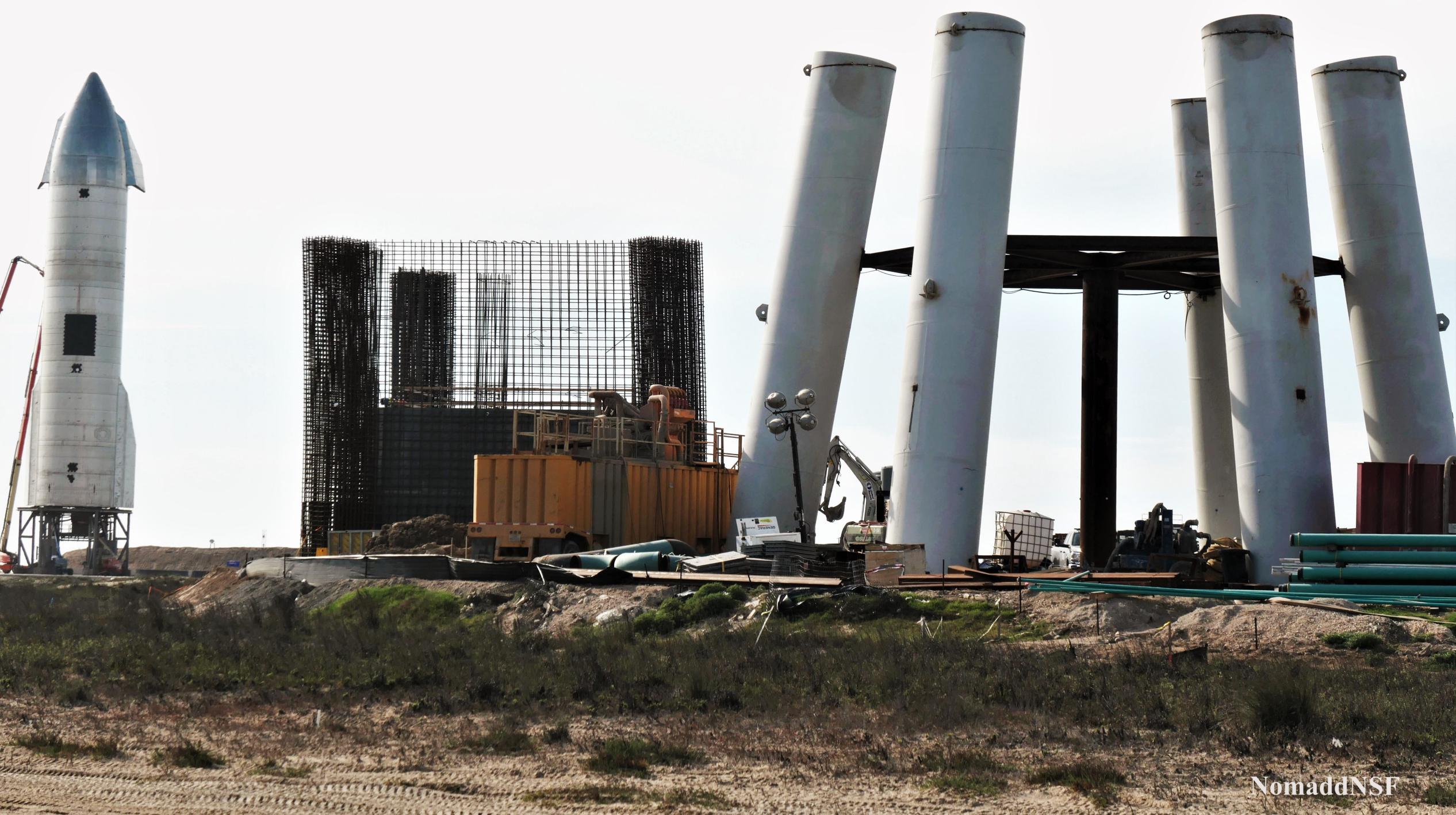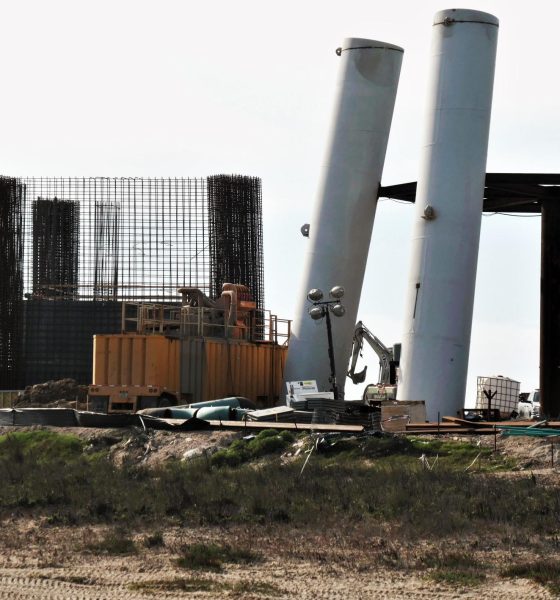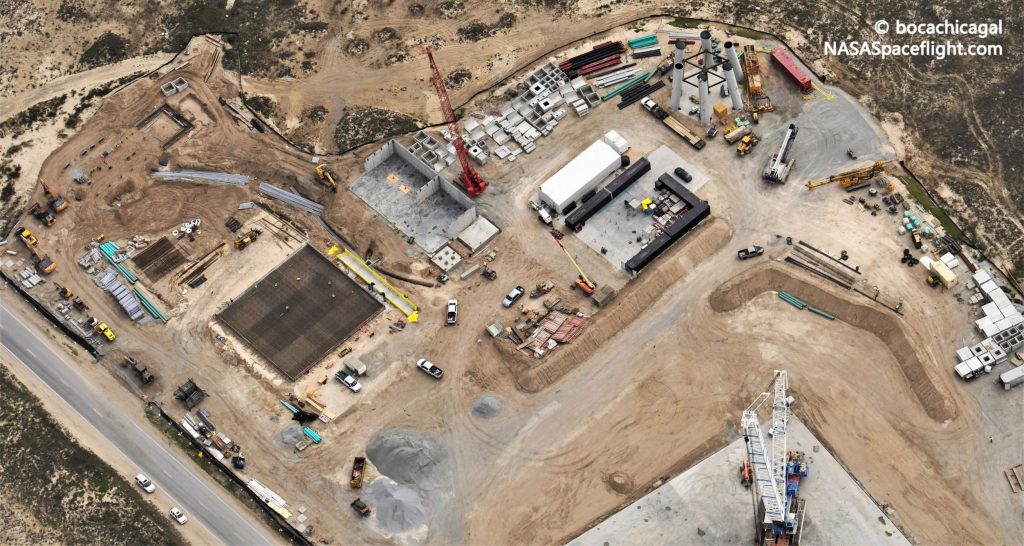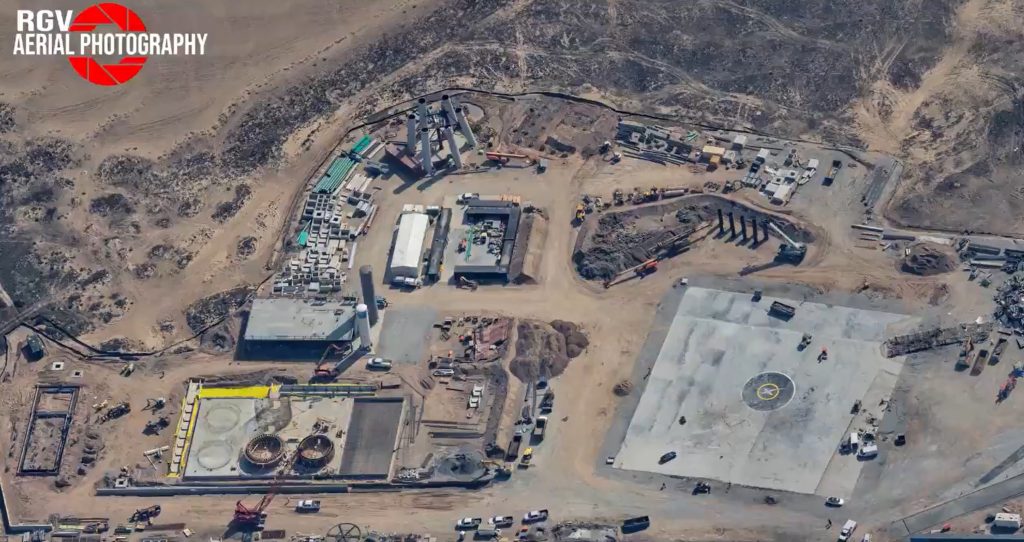

News
SpaceX’s Starship booster-catching ‘launch tower’ begins to take shape in Texas
Aerial photos show that SpaceX has rapidly begun building the first of two planned skyscraper-sized Starship ‘launch towers’ in South Texas – towers that could one day catch the Super Heavy boosters out of the air with huge arms.
CEO Elon Musk first revealed that outlandish Starship booster recovery plan around the turn of the year, followed three months later by an even wilder claim that the same booster-catching tower could also catch Starships. Around the time the idea was first floated, SpaceX was beginning to build one of two planned towers that might be outfitted with arms in the future. Progress was mostly invisible at first, hinted at only by the presence of a self-propelled drill and a few muddy holes in the right spot.
By mid-March, SpaceX had begun clearing away some of the dirt on top, revealing a beefy foundation with 25 two-foot-thick (~1m) piles buried at least 100 ft (30m) deep in the sandy wetlands. Two weeks later, the foundation has been encased in concrete and the framework for massive base is nearly ready for its first concrete pour.
In other words, SpaceX’s first South Texas launch tower has just begun to take shape and grow vertically. First and foremost, its purpose is to provide an extremely sturdy base with which SpaceX can install Super Heavy boosters on the launch mount and then install Starships on top of those boosters. Standing at least 122 meters (~395 ft) tall from tip to tail without even accounting for the launch mount/stand Starship will attach to, that seemingly simple task ends up being not so simple at all.
Situated less than a mile from the Gulf of Mexico, Boca Chica is typically an extremely windy environment at sea level – let alone hundreds of feet above ground – and the South Texas coast is almost constantly at risk of torrential rain, thunderstorms, hurricanes, and flooding. As far as building giant, sturdy towers and performing work as sensitive and precise as vertically mating rocket stages, it’s hard to imagine a viable launch site with less favorable conditions short of Siberia or the Russian steppe.
According to Musk, SpaceX’s Boca Chica launch tower will have a “hook height” (the distance from the crane hook to the ground) of at least 140m (~460 ft), meaning that the top of the tower’s crane will likely be 150-160m (490-520 ft) tall when configured to mate Starship to Super Heavy.
Beyond those general details and the occasional official SpaceX render of possible launch facilities, not much else is known about how Boca Chica’s launch tower will look and function, particularly with respect to vague plans to catch Super Heavy boosters. However, SpaceX appears to have aggressively turned its attention to building out Boca Chica’s first orbital launch facilities and the progress made in the last two months suggests that it wont be long before what was recently a dirt apron will be ready to support Starship and Super Heavy testing.


According to Musk, SpaceX’s internal goal is to attempt Starship and Super Heavy’s first orbital launch as early as July 2021. If the company continues to work around the clock on rocket’s orbital launch site as it has for the last two months, it’s far from inconceivable that the pad will be ready for that orbital launch debut even if Starship is not. Stay tuned for more updates as the pad and launch tower continue to take shape.

News
Tesla FSD fleet is nearing 7 billion total miles, including 2.5 billion city miles
As can be seen on Tesla’s official FSD webpage, vehicles equipped with the system have now navigated over 6.99 billion miles.

Tesla’s Full Self-Driving (Supervised) fleet is closing in on almost 7 billion total miles driven, as per data posted by the company on its official FSD webpage.
These figures hint at the massive scale of data fueling Tesla’s rapid FSD improvements, which have been quite notable as of late.
FSD mileage milestones
As can be seen on Tesla’s official FSD webpage, vehicles equipped with the system have now navigated over 6.99 billion miles. Tesla owner and avid FSD tester Whole Mars Catalog also shared a screenshot indicating that from the nearly 7 billion miles traveled by the FSD fleet, more than 2.5 billion miles were driven inside cities.
City miles are particularly valuable for complex urban scenarios like unprotected turns, pedestrian interactions, and traffic lights. This is also the difference-maker for FSD, as only complex solutions, such as Waymo’s self-driving taxis, operate similarly on inner-city streets. And even then, incidents such as the San Francisco blackouts have proven challenging for sensor-rich vehicles like Waymos.
Tesla’s data edge
Tesla has a number of advantages in the autonomous vehicle sector, one of which is the size of its fleet and the number of vehicles training FSD on real-world roads. Tesla’s nearly 7 billion FSD miles then allow the company to roll out updates that make its vehicles behave like they are being driven by experienced drivers, even if they are operating on their own.
So notable are Tesla’s improvements to FSD that NVIDIA Director of Robotics Jim Fan, after experiencing FSD v14, noted that the system is the first AI that passes what he described as a “Physical Turing Test.”
“Despite knowing exactly how robot learning works, I still find it magical watching the steering wheel turn by itself. First it feels surreal, next it becomes routine. Then, like the smartphone, taking it away actively hurts. This is how humanity gets rewired and glued to god-like technologies,” Fan wrote in a post on X.
News
Tesla starts showing how FSD will change lives in Europe
Local officials tested the system on narrow country roads and were impressed by FSD’s smooth, human-like driving, with some calling the service a game-changer for everyday life in areas that are far from urban centers.

Tesla has launched Europe’s first public shuttle service using Full Self-Driving (Supervised) in the rural Eifelkreis Bitburg-Prüm region of Germany, demonstrating how the technology can restore independence and mobility for people who struggle with limited transport options.
Local officials tested the system on narrow country roads and were impressed by FSD’s smooth, human-like driving, with some calling the service a game-changer for everyday life in areas that are far from urban centers.
Officials see real impact on rural residents
Arzfeld Mayor Johannes Kuhl and District Administrator Andreas Kruppert personally tested the Tesla shuttle service. This allowed them to see just how well FSD navigated winding lanes and rural roads confidently. Kruppert said, “Autonomous driving sounds like science fiction to many, but we simply see here that it works totally well in rural regions too.” Kuhl, for his part, also noted that FSD “feels like a very experienced driver.”
The pilot complements the area’s “Citizen Bus” program, which provides on-demand rides for elderly residents who can no longer drive themselves. Tesla Europe shared a video of a demonstration of the service, highlighting how FSD gives people their freedom back, even in places where public transport is not as prevalent.
What the Ministry for Economic Affairs and Transport says
Rhineland-Palatinate’s Minister Daniela Schmitt supported the project, praising the collaboration that made this “first of its kind in Europe” possible. As per the ministry, the rural rollout for the service shows FSD’s potential beyond major cities, and it delivers tangible benefits like grocery runs, doctor visits, and social connections for isolated residents.
“Reliable and flexible mobility is especially vital in rural areas. With the launch of a shuttle service using self-driving vehicles (FSD supervised) by Tesla in the Eifelkreis Bitburg-Prüm, an innovative pilot project is now getting underway that complements local community bus services. It is the first project of its kind in Europe.
“The result is a real gain for rural mobility: greater accessibility, more flexibility and tangible benefits for everyday life. A strong signal for innovation, cooperation and future-oriented mobility beyond urban centers,” the ministry wrote in a LinkedIn post.
News
Tesla China quietly posts Robotaxi-related job listing
Tesla China is currently seeking a Low Voltage Electrical Engineer to work on circuit board design for the company’s autonomous vehicles.

Tesla has posted a new job listing in Shanghai explicitly tied to its Robotaxi program, fueling speculation that the company is preparing to launch its dedicated autonomous ride-hailing service in China.
As noted in the listing, Tesla China is currently seeking a Low Voltage Electrical Engineer to work on circuit board design for the company’s autonomous vehicles.
Robotaxi-specific role
The listing, which was shared on social media platform X by industry watcher @tslaming, suggested that Tesla China is looking to fill the role urgently. The job listing itself specifically mentions that the person hired for the role will be working on the Low Voltage Hardware team, which would design the circuit boards that would serve as the nervous system of the Robotaxi.
Key tasks for the role, as indicated in the job listing, include collaboration with PCB layout, firmware, mechanical, program management, and validation teams, among other responsibilities. The role is based in Shanghai.
China Robotaxi launch
China represents a massive potential market for robotaxis, with its dense urban centers and supportive policies in select cities. Tesla has limited permission to roll out FSD in the country, though despite this, its vehicles have been hailed as among the best in the market when it comes to autonomous features. So far, at least, it appears that China supports Tesla’s FSD and Robotaxi rollout.
This was hinted at in November, when Tesla brought the Cybercab to the 8th China International Import Expo (CIIE) in Shanghai, marking the first time that the autonomous two-seater was brought to the Asia-Pacific region. The vehicle, despite not having a release date in China, received a significant amount of interest among the event’s attendees.








